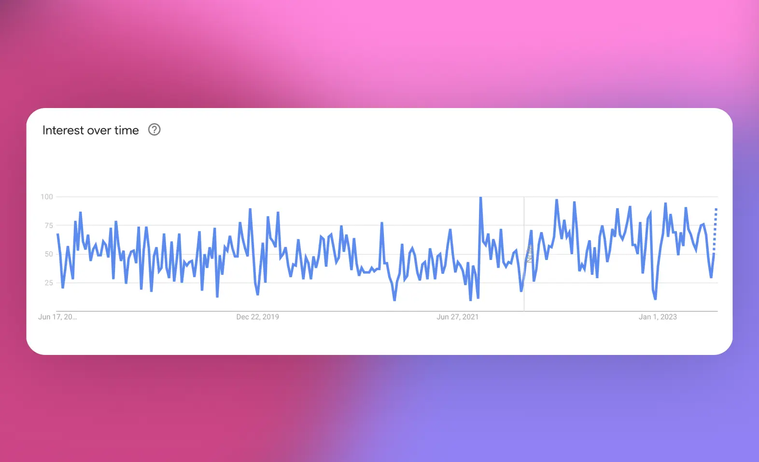Top 8 SaaS Sales KPIs to Track in 2024
2002 was a difficult year for B2C SaaS. Things went back to normal after the boom the sector enjoyed during the pandemic as the work no longer had the appetite it had for software during the pandemic. The macroeconomic changes (interest hikes and looming recession) in the U.S. brought about a change in the VC attitude toward SaaS. The “growth at all costs” mantra of the last decade was replaced by an emphasis on profitability.
With investor funds seemingly drying up, SaaS companies were forced to turn to SMB and enterprise markets where profit margins were higher. This pivot also meant a more sales-driven business model. Instead of chasing millions of customers who would make small monthly payments, more and more SaaS companies came to rely on sales teams who knew how to make a pitch and wine-and-dine executives to win 6- and 7-figure contracts.
That’s why SaaS sales KPIs are more important today than ever before, especially for companies willing to tailor their sales efforts to the needs of select customers. This blog post will take a long hard look at SaaS sales KPIs and why they matter.
What are SaaS sales KPIs?
SaaS sales KPIs are the metrics SaaS companies use to assess sales performance. They reveal how the actual sales performance of a SaaS company compares to predetermined goals, highlight problem areas, and provide insights about how the sales funnel can be optimized.
Check out this video by David Marincic for a quick intro into SaaS sales KPIs:
Key takeaways
-
Sales KPIs have become more prominent in the SaaS sector as a result of the emergence of account-based marketing practices that blend sales tactics with advanced data analytics.
-
SaaS sales KPIs help align different units around measurable goals and optimize the sales funnel, bringing accountability into the sales effort.
-
Sales KPIs are strategic-level, company-specific figures, whereas sales metrics are more tactical in nature and regarded as industry standards.
SaaS in numbers
-
The SaaS market has reached $171.9 billion by the end of 2022.
-
A study by Gartner found out that the global end-user spending on SaaS tools grew from $146 billion in 2021 to $167 billion in 2022 and forecast that it to grow by 16.8 percent in 2023, reaching $195 billion.

| Graph showing the increase in the U.S.-based Google searches for the term "sales analytics" in the last five years. Image credits: Google Trends. The image was slightly modified for aesthetic purposes.|
-
The average SaaS sales cycle lasts 84 days and can go up to 170 days for deals with an annual contract value of more than $100,000.
-
While 2 percent of sales happen at the first meeting, 63 percent of the people inquiring about a product will not make a purchase for at least three months, and 20 percent will take more than 12 months to buy.
4 main methods of selling
Before immersing ourselves in the details of SaaS sales KPIs, we should take a brief look at the four main types of sales methods and what they entail:
1- Transactional selling
Transactional selling refers to the traditional sales method where a salesperson hunts for prospects, develops a relationship with them, makes a pitch, and eventually closes the deal. It is based on temporary relationships with customers where the salesperson promotes the product, emphasizes its features, and how it will benefit the customer. The traditional 4 P’s of marketing (product, pricing, placement, and promotion) play a big role in transactional selling. Competing on product features and price, pursuing an omnichannel strategy, and running promotional campaigns are part and parcel of this technique.
With the product almost selling itself, this approach is predominantly used in industries like retail, automotive, and real estate, where sales cycles are relatively short and purchases are one-off. For most other industries, though, transactional selling is not particularly suitable because it is impersonal in nature. Using mass marketing may help lower the costs, but it also makes it impossible to address the needs of different customer groups. That’s why salespeople implementing this method fail to build long-term relationships with customers to maximize lifetime value.
2 - Solution selling
This second technique requires more personal touch from the salesperson compared to the transactional approach. In solution selling, the salesperson invests in his relationship with the customer and nurtures it to gain a deep understanding of the customer’s needs and pain points. This understanding will help him offer a solution tailored to the customer’s needs, giving him an advantage over competitors.
Solution selling involves products that tend to be complex and heavily customized rather than off-the-shelf stuff. Like in construction projects or bespoke software development, identifying the requirements and developing a solution that will create a long-term impact takes a lot of time and effort. Due to the longer sales cycle, the costs involved are higher. Therefore, solution selling makes sense only when the account in question is valuable enough to justify the extra costs.
3 - Consultative selling
Consultative selling resembles solution selling in that both require building a relationship with the customer. However, in consultative selling, the salesperson must have a lot of experience and product expertise. This expertise is the foundation of a relationship where the customer will turn to the salesperson for ideas whenever she is searching for a solution to a problem.
This strong bond with the customer enables the salesperson to ask the right questions, dive really deep into the pains she has, and offer the right solution. This technique aims to sell without making a pitch. The four important aspects of consultative selling are:
- Being a good listener
- Asking the right questions
- Being a trustworthy, objective source of knowledge
- Offering solutions, not products or features
Consultative selling envisions the salesperson as a companion to the customer and ensures that the salesperson will be top of mind when the customer is ready to make a purchase.
4 - Provocative selling
This technique is for times of drastic change where creativity is needed to improve the prospects of a sale. Provocative selling involves a “shock and awe” approach where you make your customers aware of problems they did not know existed. You aim to open their eyes to a critical need and create urgency so that they will start looking for a solution.
Times of great macro-level changes like global warming, demographic change (the emergence of Gen Z), or political upheaval (Brexit) can create massive problems for prospective customers. You can use these situations to your advantage by talking to your contacts and telling them about what that change means for the industry, their organization, and their department. Provocative selling aims to instill a “why now” mentality in contacts and kickstart a search for a solution.
The Covid-19 pandemic and the way it transformed work-life provided a case in point for how provocative selling can make a difference for SaaS teams. Practitioners of this technique used lockdowns and workplace restrictions to their advantage and pitched their products as solutions to the new pains brought about by the pandemic. We might expect more salespeople to turn to provocative selling to gain prominence as global warming, the U.S.-China standoff, and mass migration disrupt existing business models and enforce change.
KPIs vs. Metrics
Despite being used in similar contexts, KPIs and metrics refer to different concepts. In summary, “not every metric is a KPI, but every KPI is a metric.”
KPIs and metrics differ on four main points:
-
KPIs describe high-level strategic goals that tie different departments and teams together. Metrics, on the other hand, help break down these strategic goals into operative objectives.
-
KPIs communicate the priorities of a business and determine how the lower level metrics should shape up for the attainment of a business goal. Metrics are about specific processes and they gauge the effectiveness of execution.
-
Metrics reflect a benchmark or widely-acknowledged industry standard. KPIs, on the other hand, do not follow a standard form and vary according to the needs of individual organizations.
-
While metrics are related to individual employees or teams, KPIs concern various units of different sizes.
Why do SaaS sales KPIs matter?
The sales process in the SaaS sector is a long-winded one. It takes weeks and even months to close a deal. Where to start with a lead and how to proceed may be difficult to figure out for a sales rep at first. Any sales rep can feel disoriented and even lost without clear goals in place to inform actions.
Sales KPIs are these goals. They are not quotas or sales targets. They are figures that spell out what needs to be done for a business to perform to its full potential in terms of sales. Monitoring SaaS sales KPIs create three key benefits for an organization:
-
SaaS sales KPIs chart a clear route to the end goal, which is to close a deal. Working backward from the last step in the sales funnel toward the first, sales KPIs lay out how many emails you have to send to generate enough marketing-qualified leads so that you can produce enough sales-qualified leads to close enough deals to meet your objectives. In a sense, sales KPIs help quantify the whole sales funnel from the perspective of a sales rep.
-
From a management perspective, monitoring sales KPIs allow decision-makers to see how efficient the resource allocation is. Products selling better than expected can be scaled, and more sales reps can be hired to sell them. Those not meeting the expectations can be slowly phased out.
-
Sales KPIs also help decision-makers evaluate the performance of individuals. People consistently hitting their KPIs should receive consideration for bigger accounts. More training might be needed for underperforming employees.
For a discussion of what SaaS companies stand to gain from tracking sales KPIs, see this podcast episode by the Stay Paid Podcast team:
8 widely-used sales KPIs you need to track
The set of sales KPIs a company needs to track can vary depending on the industry it operates in, the business model it pursues, and the kind of challenges it needs to overcome. Here is a rundown of eight sales KPIs that are commonly tracked and what they are good for:
1 - Sales cycle length
A sales cycle is the time it takes from the initial sales contact to the time a deal is closed. It is an important KPI that speaks volumes about the efficiency of your sales operations and the success of your sales reps. Longer sales cycles mean your team will be able to close fewer deals throughout the year, which will translate into less revenue.
Why should you track sales cycle length?
Sales cycle length is a fundamental figure for planning sales operations and forecasting revenue. Knowing this figure allows you to compare your sales performance with that of the competitors and your past performance.
Who should track this KPI?
Account managers and higher-level decision-makers responsible for driving growth would be wise to track the average sales cycle length.
2 - Number of deals in the pipeline
The number of deals in the pipeline is a good indicator of sales rep activity and a predictor of sales revenue. This KPI can be broken down into the average number of deals in the pipeline and new deals added to the pipeline in a particular time frame
Why should you track the number of deals in your pipeline?
A low number of deals in the pipeline may be a sign of problems with lead generation. This might require a reconsideration of the marketing strategy, the targeted customer profile, the content used, and the performance of the channels leveraged.
Who should track this KPI?
The number of deals in the pipeline is a tactical KPI that sales reps should definitely monitor. A sustained drop in this figure is a serious cause for concern, and it may require the sales rep to take action by increasing the work rate or drawing attention to problems with lead generation.
3 - Pipeline value
This KPI calculates the maximum amount of revenue you may expect to earn from the deals in your pipeline if everything goes according to the plan. It helps users gauge where their revenue ceiling is and guides forecasting initiatives.
Why should you track pipeline value?
Tracking this metric allows you to see how likely your sales reps are to hit their quotas. If the pipeline is full, but the overall value is low, your sales reps may be wasting their time on deals that are not worth the effort.
Who should track this KPI?
This is one of the strategic level KPIs directly concerning sales managers. But, sales reps, too, would benefit from keeping tabs on pipeline value as it shows where the sales efforts are headed and makes it possible to course-correct before it is too late.
4 - Number of sales opportunities created
A sales opportunity is a qualified prospect who is highly likely to become a customer. Leads are converted into prospects, some of whom later become opportunities further down the funnel. Sales opportunities created refer to the number of these qualified prospects added to the pipeline in a given timeframe and indicate the total revenue a business can expect to generate.
Why should you track the number of sales opportunities created?
Sales opportunities created is a crucial mid-funnel KPI that tells us a whole lot about the upstream and downstream activities. A relatively low number raises questions about the target market segment and the effectiveness of the marketing tactics used. When there are plenty of sales opportunities created, but the ratio of deals won is low, then the onus is on the sales reps, who need to revisit their pitch.
Who should track this KPI?
Sales managers should keep an eye on this KPI to ensure that the sales reps are maintaining a desired level of activity and keeping the pipeline well-fed.
5 - Average deal size
The average deal size tells you a lot about your product range and what resonates with your customers. Additionally, it also provides you with objective data to evaluate the performance of your sales reps.
Why should you track the average deal size?
Because channeling marketing and sales resources into more profitable products can help a company increase revenue without incurring extra costs. Everything being equal, a higher average deal size means higher profitability. Sales reps would be wise to focus on customers that can be expected to spend more.
Who should track this KPI?
Sales reps can use this KPI to make better use of their time. For higher-level decision-makers, average deal size helps identify the popular products and phase out the ones that are not generating enough returns for every sales and marketing dollar spent.
6- Lead-to-sale ratio
This KPI reveals the overall effectiveness of the pipeline. It indicates how successful the company is in converting sales-qualified leads into prospects. Some of these prospects will become sales opportunities, some of whom will convert into paying customers.
Why should you track the lead-to-sale ratio?
This particular KPI helps users understand how efficient the whole sales effort is in generating desired results, that is, closing deals. A low lead-to-sale ratio can be indicative of the low quality of marketing-qualified leads handed over to the sales team or the channels used by the sales team while contacting prospects.
Who should track this KPI?
This KPI is one of the strategically important figures for sales managers. It helps them optimize the sales funnel and evaluate the performance of individual sales reps.
7 - Sales by contact method
Digging into the prehistory of a deal and discovering which channel was responsible for successfully engaging the customer in the first place can provide decision-makers with powerful insights. Knowing whether it’s the phone calls, emails, or in-person visits giving you a head-start in your outreach efforts can improve your sales success.
Why should you track sales by contact method?
Monitoring this metric is important for optimizing resource allocation and keeping the customer acquisition cost in check. Prioritizing more effective channels at the expense of less successful ones maximizes the return on marketing and sales dollars.
Who should track this KPI?
Sales managers can look at this KPI and remove the low-performing channels from the funnel. Sales reps, too, can match this KPI with certain customer profiles and adjust their outreach strategy, improving their conversion rates as a result.
8 - Number of monthly demos booked
The number of monthly demos booked is a good indicator of high-intent customers for SaaS companies. Usually, people who book demos are the ones that are aware of their pain points and looking for a solution.
Why should you track the number of monthly demos booked?
This KPI matters simply because people booking demos are more likely to become paying customers. Keeping an eye on this figure helps sales managers better forecast sales and plan accordingly.
Who should track this KPI?
Sales reps can use this KPI to analyze which customer profiles show more interest in demos. Focusing on these profiles can improve conversion rates and increase revenue. As stated above, sales managers also benefit from tracking this KPI for forecasting purposes.
How can Peaka help you with your sales campaigns?
Salespeople are CRM addicts. The customer information they keep on CRM platforms is their biggest asset in building relationships with prospects and turning them into paying customers.
However, with the increase in the number of SaaS tools used by sales teams, bringing together the SaaS data has become a real challenge. Data locked in isolated silos is no good unless you can consolidate it to give you a holistic view of the market and the account you are focusing on. By helping you unify your SaaS data, Peaka provides you with three major benefits:
-
Specifically, Peaka allows users to form highly-precise ideal customer profiles (ICPs) by joining and blending payment data with customer attributes from a CRM platform. It lets users see their MRR, ARPU, or LTV figures based on the pricing plan chosen and further breaks down this data into country-, industry-, or company-size-based components.
-
Armed with a well-defined ICP, it becomes much easier to personalize the messaging and produce content that will appeal to your highest-value prospects. Peaka enables you to pursue an account-based marketing strategy and improve your return on the sales and marketing dollars spent.
-
After combining your SaaS data, Peaka allows you to view the consolidated data with your favorite data visualization platform. Peaka’s dedicated connectors for popular business intelligence (BI) tools simplify this process so even non-technical employees can turn their tabular data into visualizations and draw insights.
Here are the BI tools Peaka offers ready-made connectors for:
Metabase: An open-source platform that connects to more than twenty different data sources, Metabase also offers different packages at different price points. Thanks to its Visual Query Builder and pre-made visualizations, the platform makes it easier for non-technical people to visualize their data.
Our blog post on Peaka’s Metabase integration explains how Peaka enables this user-friendly platform to retrieve and visualize data from any source.
Apache Superset™: Apache Superset™ is an open-source platform with technical capabilities that can satisfy the needs of enterprise customers. Supported by a large online community, the platform regularly gets updated with new features. Its customizability and scalability make it the ideal choice for technical teams with large datasets to visualize.
See this blog post on Peaka’s Superset integration for a more detailed discussion of this platform.
Power BI: The go-to data visualization for users working within the Microsoft ecosystem, Power BI provides native integration with Teams, SharePoint, and Microsoft 365. Its versatility makes Power BI a versatile choice for large organizations, as both technical and non-technical teams can use the same platform to visualize data.
This blog post on Peaka’s Power BI integration takes a deep dive into how Peaka allows Power BI to pull data from any source.
Looker Studio: As the standard BI tool of the Google ecosystem, Looker Studio supports hassle-free integration with Google Analytics, Google Ads, and BigQuery. Although it lacks the powerful features that some other BI tools offer, Looker Studio still appeals to a large user base thanks to its drag-and-drop interface and wide range of pre-made visualizations.
Check out our blog post on Peaka’s Looker Studio integration, explaining how Peaka enables this tool to visualize data from any source.
Tableau: For users of Salesforce products, Tableau is the default BI tool for data visualization. The platform is known for the unmatched visual appeal and variety of its visualizations. Tableau natively integrates with other Salesforce apps and is a good fit for enterprise users who have access to capable technical teams that can unlock the full feature set of the platform.
As we explain in a blog post on Peaka’s Tableau integration, Peaka ensures that this platform can connect to data sources outside the Salesforce ecosystem.
SaaS sales KPIs content to consume
- Video – 5 Fundamental Sales KPIs you Need to Track| David Marincic
- Podcast – Reach Your Goals with Sales KPIs | Stay Paid Podcast
- Podcast — The State of Sales KPIs | The Modern Sales Leader Podcast
- Article – Sales Performance| Mosaic
- Article – 21 Sales KPIs for Sales Teams to Track in 2023
- Article – 22 Sales KPIs Successful Sales Team Track in 2023
- Article – 32 SaaS KPIs Every Company Should Track2023
Conclusion
The SaaS pivot to SMBs and the enterprise segment has given a boost to account-based marketing. More and more companies are pursuing high-value accounts and trying to blend traditional sales methods with advanced data analytics. That’s why KPIs and metrics are a bigger part of the sales effort today.
Well-chosen KPIs can help align sales efforts, optimize resource allocation and improve the ROI of sales budget. They are indispensable if you are willing to introduce structure and accountability into your sales funnel.




 Please
fill out this field
Please
fill out this field









